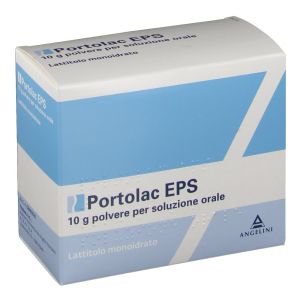Ship in Europe, Find out rates!
Language
Portolac Eps*os Polv 20bust10g

Regular Price
€10.85
Special Price
€10.07
-7%
Save: €0.78
In stock
Recent lowest price:
€9.69
- box Delivery in Italy in 24/48 and free returns
- star3.000+ positive reviews
- dropboxOver 60,000 products in the catalog
Manufacturer
ANGELINI
SKU
029563020
Active principle
LATTITOLO MONOIDRATO
NAME
PORTOLAC EPS
PHARMACOTHERAPEUTIC CATEGORY
Constipation medications.
ACTIVE PRINCIPLES
Lactitol monohydrate.
EXCIPIENTS
Powder for oral solution: none. Syrup: benzoic acid; sodium hydroxide; purified water.
INDICATIONS
The drug is indicated in the prevention and treatment of subclinical, acute and chronic porto-systemic encephalopathy: precoma prophylaxis and hepatic coma. Cirrhosis of the liver.
CONTRAINDICATIONS / SECONDARY EFFECT
Hypersensitivity 'to lactitol or to any of the listed excipients; the drug produces its effect in the colon and is therefore contraindicated in all cases in which intestinal transit is not ensured (intestinal obstruction, etc.); the medicine should not be used in case of symptoms or suspicion of organic lesion of the digestive tract and in case of any abdominal pain of unknown origin or rectal bleeding; breastfed infants and infants with hereditary autosomal recessive fructose intolerance; galactosemia; the incomplete metabolism of lactitol can lead to the development of fructosemia and galactosemia and their sequelae; pre-existing hydro-electrolyte imbalance.
DOSAGE
The dosage of the drug should be adjusted to the phase and severity of the disease. In the prevention and stabilized phases of the disease, a dosage of 0.3 g / kg of body weight per day is sufficient, equal to approximately: 20 g of drug powder for oral solution (equivalent to 2 sachets of 10 g or 4 measuring spoons of 5 g of dust); 30 ml of syrup (corresponding to 2 measuring spoons filled up to the 15ml mark); to be taken in a single evening administration. In the treatment of decompensated and acute phases of the disease, a dosage of 0.4-0.8 g / kg of body weight per day is recommended, equal to: 30-60 g of powder for oral solution (equivalent to 3-6 10g sachets or 6-12 5g measuring spoons of powder); 45-90 ml of syrup (corresponding to 3-6 measuring spoons filled up to the 15 ml mark); divided into 3 doses, at main meals. Possible dosage adjustments are 5 g of powder for oral solution or 1 measuring spoon of syrup filled up to the 7.5 ml mark per day (more or less), except for special needs in case of acute hepatic coma. The drug powder for oral solution should be dissolved in water or other drinks.
STORAGE
Powder for oral solution 10 g: store in the original package to protect the medicine from moisture. Powder for oral solution 200 g: do not store above 25 degrees C; store in the original package to protect the medicine from moisture. Syrup: this medicine does not require any special storage conditions.
WARNINGS
To avoid disturbance of the electrolyte balance caused by an overdose diarrhea, it is necessary to try to determine the optimal dosage at the beginning of the treatment to obtain two bowel movements per day in cirrhotic patients. Elderly or debilitated patients on long-term treatment with the medicinal product should regularly monitor their serum electrolytes. Before starting treatment, a pre-existing water-electrolyte imbalance must be corrected. Following treatment with the drug, hydrogen can accumulate in the intestine. Patients who need to undergo electrocautery procedures should therefore perform an intestinal cleansing with a non-fermentable solution. Patients who complain of nausea should be advised to take the medicine with meals. The product is not recommended in case of ileostomy or colostomy. Infants and children: the medicine should only be used if recommended by a doctor. Patients with rare hereditary problems of fructose intolerance, galactose, galactosemia, or glucose-galactose malabsorption should not take this medicine. In the presence of intestinal meteorism, start treatment with the minimum doses indicated, then gradually increasing them according to the clinical response. The drug has no cariogenic power.
INTERACTIONS
Since antacids and neomycin can neutralize the acidifying effect of lactitol on faeces, they should not be administered concomitantly with lactitol in cirrhotic patients with hepatic encephalopathy. The drug can 'increase the loss of potassium caused by other medicines (eg thiazo-diuretics, corticosteroids, carboxyolone, amphotericin B). Potassium deficiency may increase the risk of toxic effects of cardioglycosides in patients receiving concomitant therapy. Lactitol has a negligible caloric value (2 kcal / g or 8.5 kJ / g) and has no effect on insulin or blood glucose levels and can therefore be administered to diabetic patients.
SIDE EFFECTS
At the start of treatment, the drug may cause abdominal discomfort, mainly flatulence and rarely abdominal pain or sometimes abdominal distension. These effects tend to diminish or disappear after a few days of taking the medicine regularly. Due to inter-individual variability, some patients may experience diarrhea at the recommended dosage. This can be resolved by reducing the dosage. The adverse reactions listed below were observed in clinical studies and confirmed by spontaneous reports. The MedDRA system / organ classification is used with the following frequencies: very common (> = 1/10), common (> = 1/100 to <1/10), uncommon (> = 1/1000 to <1/100 ), rare (> = 1/10000, <1/1000), very rare (<1 / 10,000). Gastrointestinal disorders. Rare: abdominal pain, abdominal distension, diarrhea, flatulence, vomiting; very rare: nausea, abnormal gastrointestinal sounds, anal itching. The reporting of suspected adverse reactions that occur after the authorization of the drug is important, as it allows continuous monitoring of the benefit / risk ratio of the drug.
PREGNANCY AND BREASTFEEDING
Data on the use of the medicinal product in pregnant women do not exist or are limited in number. Animal studies do not indicate direct or indirect harmful effects with respect to reproductive toxicity. It is recommended to use the drug in the first trimester of pregnancy, only in case of absolute necessity. There is insufficient information on the excretion of lactitol in breast milk. It is not expected that lactitol can cause effects on newborns / infants, since the systemic exposure of lactitol to lactitol is negligible.
PORTOLAC EPS
PHARMACOTHERAPEUTIC CATEGORY
Constipation medications.
ACTIVE PRINCIPLES
Lactitol monohydrate.
EXCIPIENTS
Powder for oral solution: none. Syrup: benzoic acid; sodium hydroxide; purified water.
INDICATIONS
The drug is indicated in the prevention and treatment of subclinical, acute and chronic porto-systemic encephalopathy: precoma prophylaxis and hepatic coma. Cirrhosis of the liver.
CONTRAINDICATIONS / SECONDARY EFFECT
Hypersensitivity 'to lactitol or to any of the listed excipients; the drug produces its effect in the colon and is therefore contraindicated in all cases in which intestinal transit is not ensured (intestinal obstruction, etc.); the medicine should not be used in case of symptoms or suspicion of organic lesion of the digestive tract and in case of any abdominal pain of unknown origin or rectal bleeding; breastfed infants and infants with hereditary autosomal recessive fructose intolerance; galactosemia; the incomplete metabolism of lactitol can lead to the development of fructosemia and galactosemia and their sequelae; pre-existing hydro-electrolyte imbalance.
DOSAGE
The dosage of the drug should be adjusted to the phase and severity of the disease. In the prevention and stabilized phases of the disease, a dosage of 0.3 g / kg of body weight per day is sufficient, equal to approximately: 20 g of drug powder for oral solution (equivalent to 2 sachets of 10 g or 4 measuring spoons of 5 g of dust); 30 ml of syrup (corresponding to 2 measuring spoons filled up to the 15ml mark); to be taken in a single evening administration. In the treatment of decompensated and acute phases of the disease, a dosage of 0.4-0.8 g / kg of body weight per day is recommended, equal to: 30-60 g of powder for oral solution (equivalent to 3-6 10g sachets or 6-12 5g measuring spoons of powder); 45-90 ml of syrup (corresponding to 3-6 measuring spoons filled up to the 15 ml mark); divided into 3 doses, at main meals. Possible dosage adjustments are 5 g of powder for oral solution or 1 measuring spoon of syrup filled up to the 7.5 ml mark per day (more or less), except for special needs in case of acute hepatic coma. The drug powder for oral solution should be dissolved in water or other drinks.
STORAGE
Powder for oral solution 10 g: store in the original package to protect the medicine from moisture. Powder for oral solution 200 g: do not store above 25 degrees C; store in the original package to protect the medicine from moisture. Syrup: this medicine does not require any special storage conditions.
WARNINGS
To avoid disturbance of the electrolyte balance caused by an overdose diarrhea, it is necessary to try to determine the optimal dosage at the beginning of the treatment to obtain two bowel movements per day in cirrhotic patients. Elderly or debilitated patients on long-term treatment with the medicinal product should regularly monitor their serum electrolytes. Before starting treatment, a pre-existing water-electrolyte imbalance must be corrected. Following treatment with the drug, hydrogen can accumulate in the intestine. Patients who need to undergo electrocautery procedures should therefore perform an intestinal cleansing with a non-fermentable solution. Patients who complain of nausea should be advised to take the medicine with meals. The product is not recommended in case of ileostomy or colostomy. Infants and children: the medicine should only be used if recommended by a doctor. Patients with rare hereditary problems of fructose intolerance, galactose, galactosemia, or glucose-galactose malabsorption should not take this medicine. In the presence of intestinal meteorism, start treatment with the minimum doses indicated, then gradually increasing them according to the clinical response. The drug has no cariogenic power.
INTERACTIONS
Since antacids and neomycin can neutralize the acidifying effect of lactitol on faeces, they should not be administered concomitantly with lactitol in cirrhotic patients with hepatic encephalopathy. The drug can 'increase the loss of potassium caused by other medicines (eg thiazo-diuretics, corticosteroids, carboxyolone, amphotericin B). Potassium deficiency may increase the risk of toxic effects of cardioglycosides in patients receiving concomitant therapy. Lactitol has a negligible caloric value (2 kcal / g or 8.5 kJ / g) and has no effect on insulin or blood glucose levels and can therefore be administered to diabetic patients.
SIDE EFFECTS
At the start of treatment, the drug may cause abdominal discomfort, mainly flatulence and rarely abdominal pain or sometimes abdominal distension. These effects tend to diminish or disappear after a few days of taking the medicine regularly. Due to inter-individual variability, some patients may experience diarrhea at the recommended dosage. This can be resolved by reducing the dosage. The adverse reactions listed below were observed in clinical studies and confirmed by spontaneous reports. The MedDRA system / organ classification is used with the following frequencies: very common (> = 1/10), common (> = 1/100 to <1/10), uncommon (> = 1/1000 to <1/100 ), rare (> = 1/10000, <1/1000), very rare (<1 / 10,000). Gastrointestinal disorders. Rare: abdominal pain, abdominal distension, diarrhea, flatulence, vomiting; very rare: nausea, abnormal gastrointestinal sounds, anal itching. The reporting of suspected adverse reactions that occur after the authorization of the drug is important, as it allows continuous monitoring of the benefit / risk ratio of the drug.
PREGNANCY AND BREASTFEEDING
Data on the use of the medicinal product in pregnant women do not exist or are limited in number. Animal studies do not indicate direct or indirect harmful effects with respect to reproductive toxicity. It is recommended to use the drug in the first trimester of pregnancy, only in case of absolute necessity. There is insufficient information on the excretion of lactitol in breast milk. It is not expected that lactitol can cause effects on newborns / infants, since the systemic exposure of lactitol to lactitol is negligible.
| Destination | Cost | Detail |
|---|---|---|
| Italy | €5,90* | 24/72H |
| Austria, France, Germany, Slovenia | € 13* | 3 days |
| Belgium, Luxembourg, Portugal, Netherlands, Spain | € 14* | 4 days |
| Bulgary, Cechia, Hungary, Poland, Romania, Slovakia | € 19* | 5 days |
| Denmark, Estonia, Finland, Ireland, Lithuania, Latvia ,Sweden | € 22* | 5 days |
| United Kingdom, Switzerland, Greece, Malta/td> | € 30* | 7 days |
| Canada | € 40 | 7 Days |
European shipments with express courier: FedEx, MBE, DHL
*For the shipment outside band B ther's an extra cost of 22€ *For the shipment outside band C ther's an extra cost of 30€ Delivery Times exclude Saturday and Holidays
For Islands and Areas of difficult Accessibility the shipments are made in 72 hours and the cost will be increased by 15€
The images of the products shown on our site are purely indicative and may differ in shape, color, text and packaging shown on them. Given the difficulty of updating all the products on our site in real time or any errors, XFarma.it, all products will be identified through SKU MINSAN (code of the Ministry of Health).


